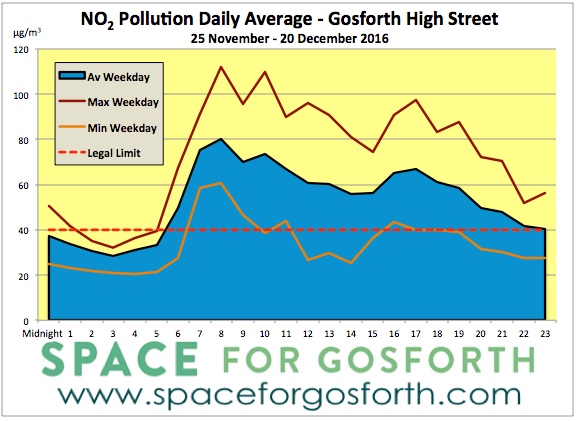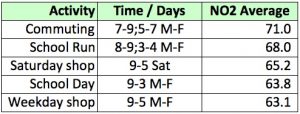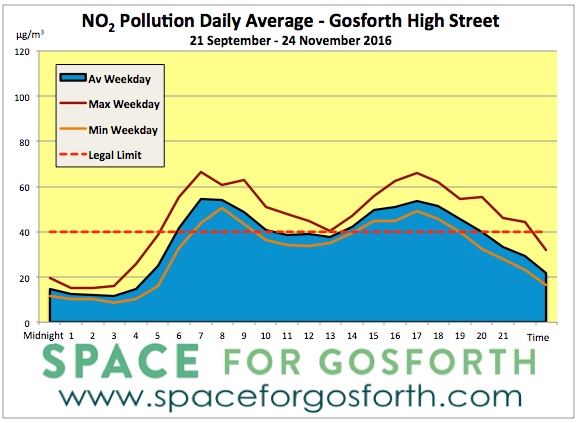Since Black Friday, 25 November 2016, readings from the new air quality monitor at the Salters Road car park say the average level of nitrogen dioxide (NO2) has been 50.3 micrograms per cubic metre (μg/m3) or 26% above the legal limit. The legal limit is 40 μg/m3 averaged over a year. It was high levels of nitrogen dioxide that led to the creation of the South Gosforth Air Quality Management Area in 2008.
While air pollution is damaging to health, personal exposure travelling further by car to an out of town centre rather than Gosforth High Street is likely to be even greater, and if you are able to walk or cycle instead, the benefits of doing have been shown to outweigh the negative impact of pollution.
The graph above shows average readings for each hour over the course of a weekday, with the maximum and minimum lines showing the highest and lowest average values. During this period, the average pollution on weekdays (the black line) has only been under the legal limit between midnight and 5am. For the most part the highest readings are from the Monday average and the lowest readings from Wednesday and Thursday. The highest reading overall was 217.1 μg/m3, recorded on Monday 28 November between 8.15am and 8.30am.
Each year in the UK around 40,000 deaths are attributable to exposure to outdoor air pollution, which is about 106 people dying every day of the year. These deaths and other illnesses caused by air pollution reportedly cost the UK economy £20bn per year. We have previously looked at the different health conditions caused by air pollution, including cancer, infertility and heart and lung disease, as these formed part of our objections to the original plans for the Blue House Roundabout (also part of the South Gosforth Air Quality Management Area).
Air pollution is harmful to everyone. According to the Royal College of Physicians, some people suffer more than others because they live, learn or work near busy roads or are more vulnerable because of their age or other medical conditions. This would include residents living on the Great North Road/Gosforth High Street, children going to school at Gosforth Academy and other nearby Gosforth schools and people who work on Gosforth High Street. For those passing through, the most affected will be people travelling by car, especially children and older passengers, as pollution can become more concentrated inside vehicles.
In Gosforth these graphs show that the primary source for NO2 air pollution is from vehicle exhausts. Consumer organisation Which? found that, as well as almost all modern diesel cars exceeding nitrogen dioxide emissions limits, “one in ten petrol cars produced so much NOx that they too are breaking emission limits“.
Although the South Gosforth Air Quality Management Area is the result of high concentrations of nitrogen dioxide, SPACE for Gosforth’s own monitoring last year showed that particulate matter (PM2.5) levels are also a cause for concern with recordings consistently above the WHO limit. PM2.5 is also emitted predominately from diesel exhausts as well as from wear and tear on tyres and brakes.
With this new data we can estimate the typical exposure for different activities during the last month. For a child travelling to school between 8am and 9am then returning home between 3pm and 4pm, the average exposure during that journey would have been 68.0 μg/m3. The worst air quality would have been experienced by someone commuting between 7am and 9am in the morning and 5pm and 7pm at night.
Prior to Black Friday, pollution levels were not as bad but still high overall, averaging 34.9 μg/m3 for the previous two months including the October half term. This is a reduction compared to monthly averages from October in previous years, which have been 50 μg/m3 or more, though those averages were from sites further south on Gosforth High Street.
This reduction may be due to the new single lane operation going north meaning that, although there may be the same number of vehicles and pollution overall, the impact is spread over a wider area. It could also be indicative of the temporary benefit of a higher capacity junction before vehicle usage rises to fill the new capacity, though ultimately this will lead to worse air quality.
We can also determine from this graph that background (non-traffic) NO2 levels are less than 10 μg/m3, as have been recorded between about midnight and 4am.
For those that wish to look at the source data themselves it is available on-line from the Newcastle Urban Observatory . The data used in the above graphs is from the Aq_Mesh High Precision Air Monitor located in the Salters Road car park. Measurements of NO2 are recorded in parts per billion (ppb) which need converting to μg/m3. As a guide, at winter temperatures, μg/m3 are approximately double ppb figures.
The air quality monitor is part of the Urban Observatory project, showing real-time sensor feeds from across the city. These sensors are deployed by Newcastle University and other partners.




I would guess we would all like to see air pollution reduced.
However, you have repeated the assertion that 40,000 deaths are due to air pollution. There was an interview on the Sunday Politics last Sunday. Andrew Neill interrogated the Greenpeace chief and this claim was demolished. It doesn’t have ‘air pollution’ as the main reason for death on a death certificate. Air pollution can have a contributory factor especially if someone has breathing problems already.
We were all told a few years ago that diesel cars were preferable to petrol. We now know that the emissions tests on some cars were essentially faked. So, we are back to square one on that issue.
Looking at the emissions near Salters car park it is clear that emissions are some of the highest during the School run. There must be some determined action to reduce the numbers being driven to school by various initiatives otherwise everything expended about this air pollution problem is just hot air.
Thanks for the comment Michael. Just for reference, the figure of 40,000 deaths was taken from a report by the Royal College of Physicians entitled ‘Every Breath we Take’. You are right to say that pollution isn’t listed on death certificates however it is still possible to estimate the number of deaths. This is just the same as smoking which is also known to be a cause of lung disease but rarely itself listed on death certificates.
This is the link for the report.
https://www.rcplondon.ac.uk/projects/outputs/every-breath-we-take-lifelong-impact-air-pollution
I saw the daily politics coverage too. It seemed to me to a bit of silly arguement, since as Andrew Neil likes to do – focus on a single statistic and try to undermine an entire campaign (whether anyone agrees with the campaign or not!). I wasn’t sure what he was trying to say? The statistic is flawed therefore pollution is ok? There is mountains of evidence from around the world that pollution is bad for you.. whether that results in 40,000 attributable deaths or 28,432 is pretty much irrelevant.
We all just want clean air and in particular for our children.
We do all want clean air but propaganda is not really going to help the cause.
Whatever the figure is, I think we can all agree that it is far too high. I’d be very interested in hearing what people would like to see happen to help reduce pollution levels in Gosforth.
It seems to me that the only solution that the Council can see to reducing air pollution around Gosforth High Street is to try to speed the traffic flow through the new junction with Salters Road in a North-South-North direction. They have already changed the priority on the pedestrian crossing outside the Halifax so that pedestrians often have to wait longer and the tail back of traffic goes right the way back to the crossing outside the shopping centre. Now they propose to remove the 30/31 bus stop at the North end and have those buses stop at an enlarged bus stop opposite the Brandling. Surely this will merely result in a longer queue of buses across the bottom of Ivy road and the pedestrian crossing.
The new junction layout may have resulted in faster traffic flow across the Salters Road- Church Road direction, but it has done nothing for flow and pollution in the South/ North axis. Also, pedestrians are very confused about where to look when waiting for lights to change (why can’t we have indicator lights on the opposite side of the road?) . Also, a word of warning if you are cycling from the North and want to turn right into Salters Road; don’t go into the narrow part of the box to wait to turn, because frustrated motorists queuing to come out of town regularly shoot down the right turn lane for Church Road and then cut in at speed to go North ( I had one come within a metre of me when I was waiting).
All in all we have (in the Council) a group of headless chickens in a rush to claim straight jacket government money that can only be used to further the wrong transport policies; putting vague promises of commuter housing and ‘Northern Powerhouse’ fantasy above real planning for residents needs.
I guess there multiple things that could be done (provided brave politics…)
1. Ban all Diesel engines from high pollution zones (>40 NO2 average) starting 2018
2. Change all public transportation to electric
3. Taxis should be Hybrids
4. Disallow car traffic with only 1 passenger between certain times (eg 8-9 am) in high pollution zones
5. Inflict high penalties (higher than parking tickets in Gosforth)
I have seen some of these measures been taken in cities like Stockholm already 25 years agooo
Whilst everyone would agree that a well run, integrated, frequent and value for money Metro system is a part of the solution for Newcastle Transport, it doesn’t help when Nexus reduce the the number of morning peak trains from Regents Centre into Newcastle and beyond by 25% as they have today and with a third of those remaining being able to be cancelled without any affect on them running a ‘good service’. I wonder what effect this will have on the number of vehicles running along GHS and elsewhere at peak times?